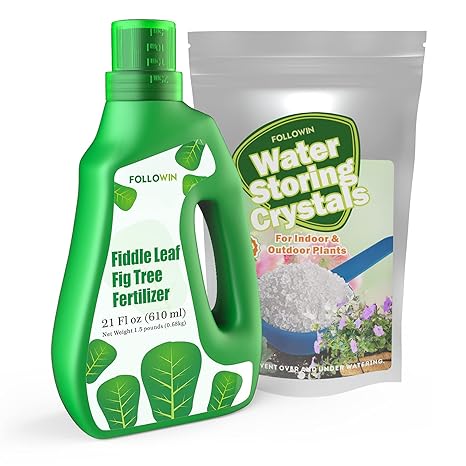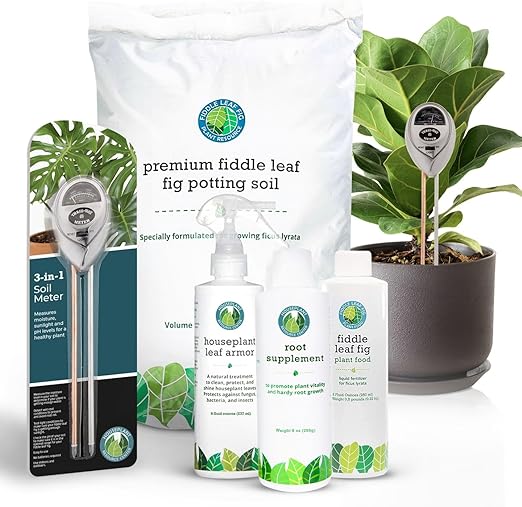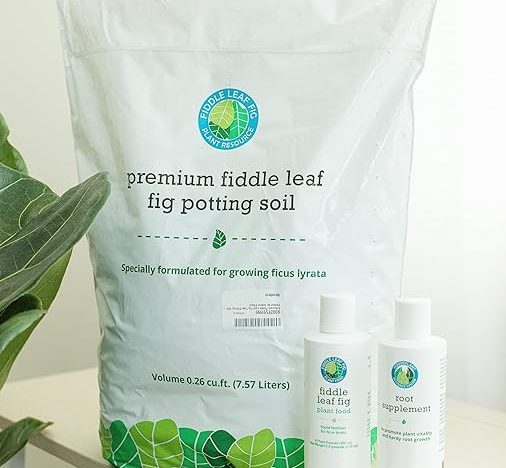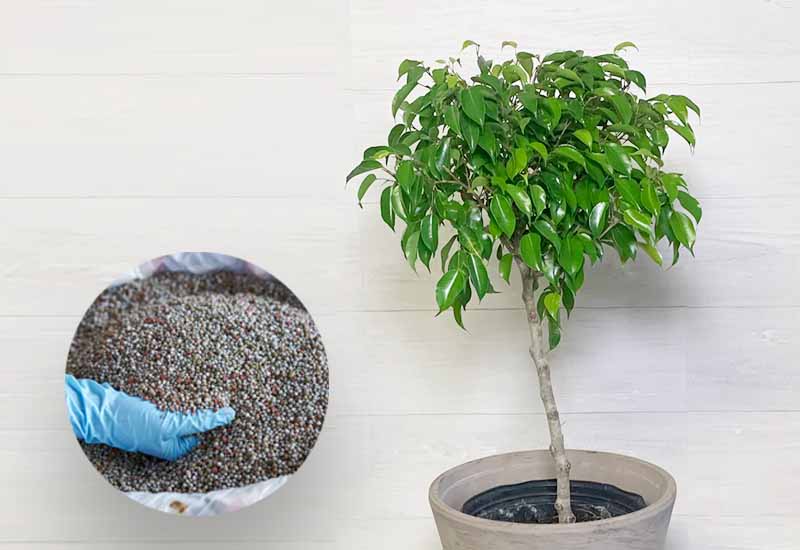10 Expert Tips for Choosing the Best Fertilizer for Ficus Tree
The right fertilizer for Ficus tree can make a world of difference in the health and vitality of your plant. Ficus trees are renowned for their lush green foliage and ability to bring natural beauty to indoor and outdoor spaces. Proper care ensures these trees thrive and maintain their vibrant appearance. One crucial aspect of Ficus tree care is fertilization. In this guide, let’s delve into exploring the best fertilizer for Ficus tree, explaining why it’s so important to their health, and offering insights into choosing the right fertilizer.

Ficus
Fertilizer
Fiddle Leaf Fig Tree Fertilizer (21 Ounces)

Ficus Fertilizer
Fiddle Leaf Fig Tree Fertilizer (21 Ounces)

Ficus Fertilizer
Fiddle Leaf Fig Tree Fertilizer (21 Ounces)
Why Fertilizing Ficus Tree is Important

Fertilization plays a pivotal role in the well-being of Ficus tree. These trees, which include popular varieties like the Weeping Fig (Ficus benjamina), the Fiddle Leaf Fig (Ficus lyrata), and the Rubber Plant (Ficus elastica), have specific nutrient requirements to sustain their growth and vibrant foliage. Fertilizing Ficus trees provides these essential nutrients, promoting healthy root development, robust leaf growth, and overall vitality.
Types of Fertilizers for Ficus Tree
Regarding fertilizers for Ficus tree, not all products are created equal. Understanding the types of fertilizers available is crucial for choosing the right one for your trees.
Choosing the Right Fertilizer
Synthetic vs. Organic Fertilizers: Synthetic fertilizers release nutrients quickly, while organic options release them more gradually. Choose based on your preferences and the specific needs of your Ficus tree.
Slow-Release vs. Liquid Fertilizers: Slow-release fertilizers provide a steady nutrient supply over time, reducing the frequency of application. Liquid fertilizers offer a more immediate nutrient boost. Your choice should align with your care routine.
When and How to Fertilize
Timing and application methods are key factors in effective Ficus tree fertilization.
Seasonal Timing and Application Methods
Seasonal Timing: Fertilize your Ficus tree during the growing season, typically in spring and summer. Avoid fertilizing during the dormant period in fall and winter when growth slows.
Application Methods: For in-ground Ficus tree, spread the fertilizer evenly beneath the tree’s canopy, avoiding direct contact with the trunk. For potted Ficus tree, dilute the fertilizer according to package instructions and apply it to moist soil to prevent root burn.
Nutrient Requirements
Ficus tree have specific nutrient needs essential for their health and growth. Understanding these nutrient requirements is fundamental to effective fertilization.
Essential Macronutrients and Micronutrients
Macronutrients: The ficus tree requires three primary macronutrients:
Nitrogen (N) promotes lush foliage and overall growth.
Phosphorus (P) supports root development and flowering.
Potassium (K) aids in disease resistance and stress tolerance.
Micronutrients: Vital micronutrients include:
Iron (Fe), which prevents yellowing leaves (chlorosis).
Magnesium (Mg) is essential for photosynthesis.
Zinc (Zn) is important for enzyme function.
Understanding and meeting these nutrient requirements is crucial for maintaining the vibrancy and vitality of your Ficus tree.
Troubleshooting and Special Considerations
Fertilization isn’t always straightforward, and Ficus tree may face unique challenges. Here, we explore how to troubleshoot issues and navigate special situations.
Addressing Fertilizer Issues and Unique Situations
Signs of Overfertilization: If your Ficus shows signs of fertilizer burn, such as brown leaf edges or leaf drops, flush the soil with water to dilute excess nutrients. Adjust your fertilization schedule accordingly.
Signs of Nutrient Imbalances: Yellowing leaves, stunted growth, or poor foliage can indicate nutrient imbalances. Conduct a soil (Best Soil For Ficus) test to identify deficiencies or excesses and adjust your fertilizer accordingly.
Special Considerations: Newly planted Ficus tree, mature trees, and those in different environments (indoors vs. outdoors) may require specific fertilization approaches. Tailor your care to their unique needs.
Summary of Key Fertilization Practices for Healthy Ficus Tree
Understand Nutrient Needs: Ficus tree require essential macronutrients (N, P, K) and micronutrients (Fe, Mg, Zn) for robust growth.
Choose the Right Fertilizer: Select a fertilizer based on your tree’s needs, considering synthetic vs. organic options and slow-release vs. liquid formulations.
Timing and Application: Fertilize during the growing season (spring and summer) using appropriate application methods for in-ground or potted Ficus tree.
Troubleshooting: Be vigilant for signs of overfertilization or nutrient imbalances and take corrective actions promptly.
10 FAQs About Fertilizer for Ficus Tree
1. How often should I fertilize my Ficus tree?
Fertilize during the growing season (spring and summer) every 4-6 weeks. Reduce or stop fertilizing during the dormant period in fall and winter.
2. Can I use fertilizer for Ficus tree, or should I look for a specific type?
It’s best to choose a fertilizer with balanced ratios of nitrogen (N), phosphorus (P), and potassium (K), unless you identify specific nutrient deficiencies through soil testing. Slow-release or liquid fertilizers can work, depending on your preference and care routine.
3. What signs should I look for to determine if my Ficus tree needs fertilization?
Signs of nutrient deficiencies include yellowing leaves, stunted growth, or poor foliage. If your Ficus shows these symptoms during the growing season, it may benefit from fertilization.
4. Can I use compost or mulch instead of chemical fertilizers for Ficus tree?
While compost and mulch can enrich the soil over time, they may not provide all the necessary nutrients. Using a balanced fertilizer is advisable to meet your Ficus tree’s specific nutrient requirements.
5. Should I fertilize my indoor Ficus tree differently from my outdoor Ficus tree?
Indoor and outdoor Ficus tree may have different needs due to variations in lighting and environmental conditions. Adjust your fertilization routine based on your specific tree’s location and needs.
6. What should I do if my Ficus tree shows overfertilization, such as leaf burn?
If you suspect overfertilization, flush the soil with water to dilute excess nutrients. Adjust your fertilization schedule, using a lower concentration or less frequent applications.
7. How do I address nutrient imbalances in my Ficus tree’s soil?
Conduct a soil test to identify nutrient deficiencies or excesses. Based on the results, adjust your fertilizer to provide the lacking nutrients or reduce the levels of excess nutrients.
8. Can I use the same fertilizer for all my indoor houseplants, including Ficus tree?
Ficus tree, like other indoor plants, have specific nutrient requirements. While some fertilizers may work for a range of houseplants, it’s advisable to consider the unique needs of each plant species and adjust your fertilization routine accordingly.
9. Are there any alternatives to traditional fertilization methods for Ficus tree?
Yes, alternatives include organic compost and mulch, foliar feeding, and controlled-release fertilizers. These methods can be effective, but it’s essential to choose the one that best suits your care routine and the needs of your Ficus tree.
10. How can I tell if my Ficus tree is dormant and doesn’t require fertilization?
Ficus tree typically go dormant in fall and winter when growth slows. Signs include reduced leaf production and slowed growth. It’s generally best to refrain from fertilizing during this period and resume in spring when the growing season begins again.







